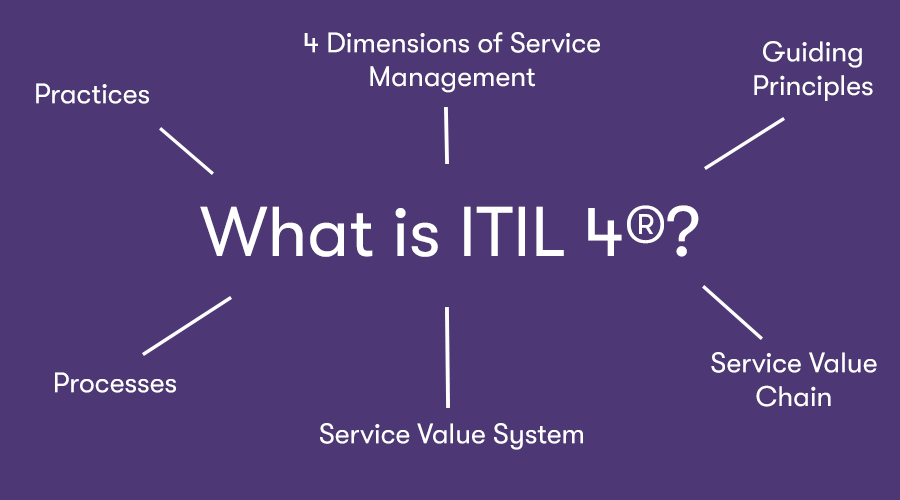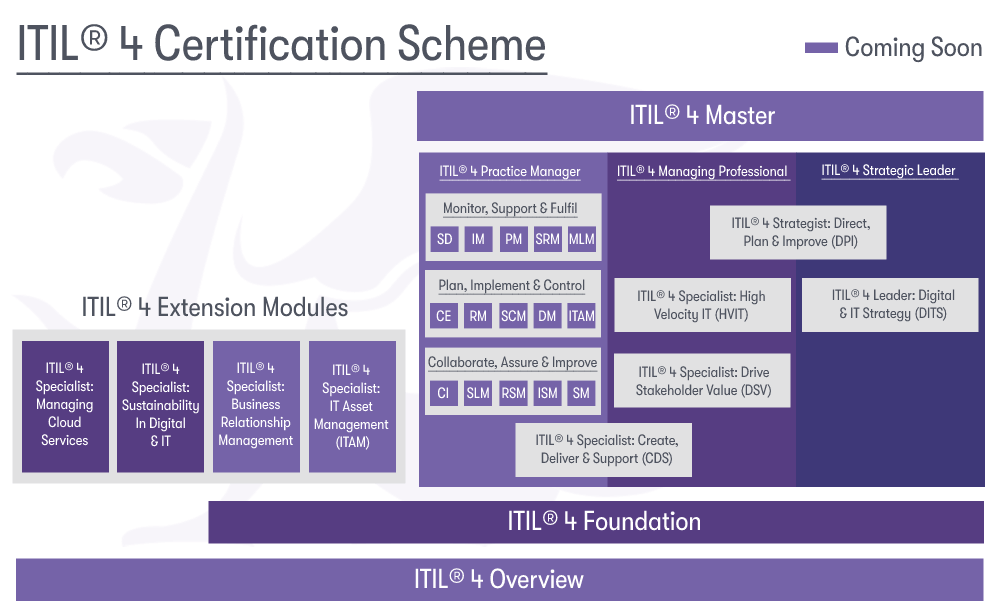What is ITIL 4®? Framework, Process and Principles
Whether you're new to ITIL or looking to broaden your knowledge of IT Service Management, this guide will provide you with a clear understanding of the ITIL 4 framework, its practices, processes, and its principles.
I'll explain the basics of ITIL 4, including the key concepts, terminology, and how it can help your organisation to manage your IT services effectively. So, if you're ready to learn more about ITIL 4, let's dive in!
- What Does ITIL Stand For?
- What is the ITIL Framework?
- What is the Service Value System (SVS)?
- What are the four dimensions of service management?
- What is the Service Value Chain?
- What are the ITIL 4 Practices?
- What Are the Guiding Principles of ITIL?
- What Is ITIL 4? How is it Different to ITIL V3?
- What are the Advantages of Using the ITIL 4 Framework?
- What are ITIL Processes and What Are They For?
- What Qualifications Can You Gain for ITIL 4?
- Where Can You Learn More About ITIL 4?
- Final Notes on The ITIL 4 Framework
What Does ITIL Stand For?
ITIL stands for Information Technology Infrastructure Library. Although ITIL is now considered its own brand and no longer refers to the IT infrastructure library. It is currently on its 4th iteration, called ITIL 4, which is named after the 4th Industrial Revolution.
What is the ITIL Framework?
The ITIL 4 framework provides guidelines for managing and delivering IT services. It is a set of best practices for IT service management that is widely used by organisations around the world.
ITIL 4 was first released in 2018 and is the latest version of the ITIL framework. It builds on the previous versions of ITIL, incorporating feedback and insights from industry experts and practitioners to address the evolving needs of IT service management in the modern digital age.
Essentially the ITIL 4 framework is the Service Value System (SVS), which provides a holistic view of ITSM and how it supports business objectives. This framework is used for creating, delivering, and continually improving services that meet the needs of customers and stakeholders. The ITIL SVS is the core of ITIL 4, the latest version of the ITIL framework.
What is the Service Value System (SVS)?
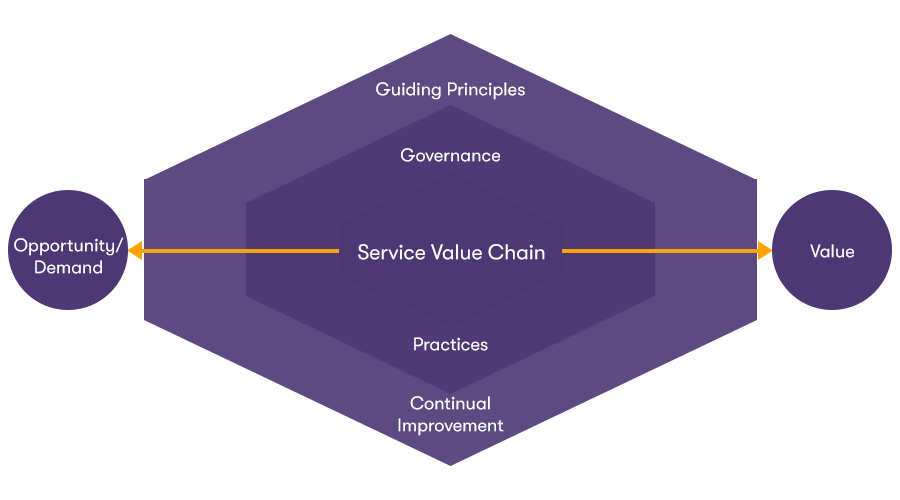
The ITIL SVS consists of several components that work together to support the delivery of services, including:
The Service Value Chain (SVC)
This is a series of interconnected activities that create and deliver value to customers. The SVC includes six key activities: Plan, Improve, Engage, Design & Transition, Obtain/Build, and Deliver & Support.
Guiding Principles
These are recommendations that guide organisations in the use of the ITIL framework. The 7 guiding principles are designed to help organisations create and deliver services that are customer-focused, collaborative, and value-driven.
Governance
This refers to the framework of policies, procedures, and decision-making processes that ensure services are delivered in a controlled and compliant manner. Governance ensures that services are aligned with organisational goals and objectives.
Continual Improvement
This is an ongoing process of evaluating and improving services to meet changing customer and business needs. Continual improvement ensures that services are always meeting or exceeding customer expectations.
Practices
These are sets of organisational resources designed to carry out specific types of work. The ITIL 4 framework includes 34 practices, which are grouped into three categories: general management practices, service management practices, and technical management practices.
The ITIL SVS is designed to be flexible and adaptable to meet the needs of organisations of all sizes and industries. By following the ITIL SVS your organisation can create and deliver high-quality services that meet the needs of your customers and stakeholders while also driving business value and growth.
(Click here for an in-depth look at ITIL 4 Management Practices).
What are the four dimensions of service management?
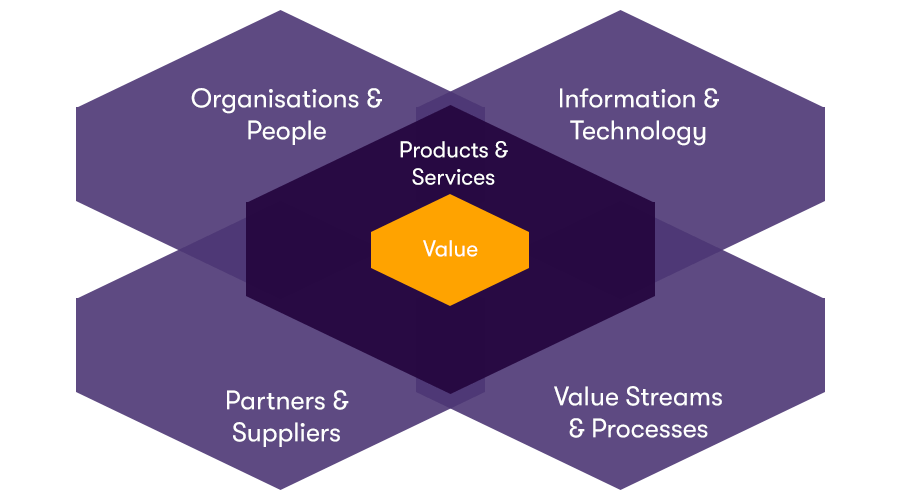
The ITIL 4 framework is designed to be more flexible and adaptable than previous versions, enabling organisations to tailor their ITSM approach to their specific needs and goals. It consists of the four dimensions of service management: organisation and people, information and technology, partners and suppliers, and value streams and processes.
Organisational and people
This dimension covers the organisational structure, governance, and culture of the organisation. It helps to ensure that the organisation is structured and governed in a way that supports the delivery of value through IT services.
The dimension covers the people involved in delivering and using IT services, including customers, users, and staff. It ensures that the right people are in place to deliver value, and that they have the right skills, competencies, knowledge, and behaviours to do so.
Information and technology
This dimension includes all the hardware, software, and information used in the provision of services. It focuses on how technology can be leveraged to create value for customers and the organisation. It includes the design of technology systems and how they are integrated to support service delivery.
Partners and suppliers
This dimension covers the relationships and interactions between the organisation, and its partners and suppliers. It helps to ensure that the organisation is working effectively with its partners and suppliers to deliver value.
Value streams and processes
This dimension covers the value streams and processes that are used to deliver IT services. It helps to ensure that the value streams and processes are designed and operated in a way that supports the delivery of value.
These four dimensions are interdependent and must be considered to ensure that the organisation is able to deliver value through IT services effectively.
What is the Service Value Chain?

The ITIL 4 Service Value Chain helps organisations by providing a comprehensive framework for understanding the end-to-end process of delivering value through IT services.
The six value chain activities are:
- Plan
- Improve
- Engage
- Design and Transition
- Obtain/Build, Deliver
- Support
These activities represent tasks an organisation takes to create value. Each of the activities turns inputs into outputs.
Plan
The plan value chain activity ensures a shared comprehension of the organisation's vision, its current status, and an improvement direction for all products and services the organisation delivers.
Improve
The improved value chain activity ensures continual improvement of products, services and practices.
Engage
The engage value chain activity is to provide a shared understanding of stakeholder needs. Provide transparency and continual engagement with stakeholders and to ensure a good relationship.
Design and Transition
The design and transition value chain activity ensures that the quality, cost, and time to market of products and services continually meet the requirements of stakeholders.
Obtain/Build
The obtain/build value chain activity ensures that service components are available when required and meet the agreed specifications.
Deliver and Support
The deliver and support value chain activity ensures that services are delivered and maintained to the agreed specifications and to the satisfaction of the stakeholders.
Overall, the ITIL 4 framework provides organisations with a comprehensive set of tools and practices for delivering high-quality IT services that align with business objectives and deliver value to customers.
What are the ITIL 4 Practices?
A practice is the best way to achieve the outcomes that we desire. A Practice is made up of people, processes and technology.
Processes are fundamental to practices, but so is the technology that automates our optimised process, and so are the various people who have the correct skills and capabilities to ensure the processes achieve the best outputs and allows our customers to achieve their best business outcomes.
ITIL 4 introduced 34 practices that can be split into 3 categories: General management practices, service management practices, and technical management practices.
| General Management Practices | Service Management Practices | Technical Management Practices |
| 1. Architecture management | 15. Availability management | 32. Deployment management |
| 2. Continual improvement | 16. Business analysis | 33. Infrastructure and platform management |
| 3. Information security management | 17. Capacity and performance management | 34. Software development and management |
| 4. Knowledge management | 18. Change enablement | |
| 5. Measurement and reporting | 19. Incident management | |
| 6. Organisational change management | 20. IT asset management | |
| 7. Portfolio management | 21. Monitoring and event management | |
| 8. Project management | 22. Problem management | |
| 9. Relationship management | 23. Release management | |
| 10. Risk management | 24. Service catalogue management | |
| 11. Service financial management | 25. Service configuration management | |
| 12. Strategy management | 26. Service continuity management | |
| 13. Supplier management | 27. Service design | |
| 14. Workforce talent management | 28. Service desk | |
| 29. Service level management | ||
| 30. Service request management | ||
| 31. Service validation and testing |
General Management Practices
Architecture management
This practice provides and understanding of how different elements within an organisation interrelate. It provides the principles, standards and tools to help organisations make complex organisational changes to effectively achieve its current and future objectives.
Continual improvement
The continual improvement practice aligns the organisations practices and services with the changing of business needs. This is done by the ongoing improvement of any element involved in the management of products or services.
Information security management
This practice is to protect information that is vital to the organisation to perform its business. Information security management implements preventions and precautions of breaches to reduce the risk of confidential data being leaked. Along with the integrity on the information, the security of the data, the data must be readily accessible to authorised parties when necessary.
Knowledge management
This practice focuses is to maintain and improve the use of information and knowledge across an organisation. This includes the convenience and how the data is being used.
Measurement and reporting
Measurement and reporting practices help to inform good decision making, by ensuring data on various managed objects is relevant, and the assessment of this data is correct within its appropriate context. Managed objects include, but are not limited to, products and services, practices and value chain activities, teams and individuals, suppliers and partners, and the organisation as a whole.
Organisational change management
The organisational change management practice is designed to manage the human aspect of changes, to deliver successful and long-lasting benefits to the organisation. This is achieved through stakeholder and sponsor management, good communication and reinforcement.
Portfolio management
Portfolio management ensures that the organisation has the correct resources, including, but not limited to programmes, projects, and products or services. These resources must contribute to the organisations strategy and provide value.
Project management
The project management practice ensures that projects in an organisation are delivered successfully and to schedule. This is achieved through planning, delegating, monitoring, motivating, and managing all aspects of the project. Different approaches can be considered, depending on the project. Waterfall, and Agile methodologies are the most adopted practices.
Relationship management
Relationship management practice nurtures links between the organisation and its stakeholders. The practice ensures that the stakeholder’s needs are understood, and their satisfaction levels are high, at the same time ensuring that the customer’s priorities are met. The organisation must facilitate value creation for stakeholders in line with its strategy.
Risk management
The Risk management practice ensures the organisation understands, and effectively handles risks. Risk management identifies, implements preventions, and addresses risks. This practice minimises service disruption as well as creating value for the organisation’s customers.
Service financial management
To support the organisations objectives and strategies, service financial management ensures its financial resources are allocated correctly and are being used effectively to create value. For financial management to be successful, risks must be assessed, and resources are to be monitored and reviewed.
Strategy management
Strategy management establishes an organisations goals and objectives. To achieve these goals strategy management must allocate resources, drive the organisations direction, implement through strategic plans on all levels, and be agile in response to environments. The organisations strategy must enable value for the organisation. The practice ensures that the strategy is defined, agreed, maintained and ultimately achieved.
Supplier management
The supplier management practice ensures that the organisations suppliers’ performance is monitored and managed appropriately in accordance with your contact. Reduce risk of failure and increase value by ensuring a closer, more collaborative relationship through a single point of visibility and consistency.
Workforce talent management
This practice focuses on matching people with the appropriate skills and knowledge with the subsequent role, to provide the organisation with a more effective employee resource, to assist the business in reaching its goals. Workforce talent management ensures this through effective performance measurements, KPI’s (key performance indicators), learning and development, recruitment, and succession planning.
Service Management Practices
Availability management
Availability management practice ensures that services deliver the agreed levels of availability to meet the customer, and user needs. This is obtained by designing suitable infrastructure, monitoring and analysis, and planning improvements to increase service satisfaction.
Business analysis
Business analysis practice analyses an element of a business, defines its need, and recommends solutions to solve a business’ problems or needs. These changes must facilitate value for stakeholders and align with the organisation’s objectives.
Capacity and performance management
Capacity and performance management practices ensure that services deliver the agreed and expected performance whilst fulfilling current and forecasted demand in a cost-effective way. This is achieved through monitoring, infrastructure management, capacity planning, and forecasting.
Change enablement
Change enablement practice is to achieve successful IT changes efficiently. This is enabled by conducting risk assessments, authorising changes before proceeding, and defining how the changes should be managed.
Incident management
The purpose of the ITIL incident management practice is to restore normal service operations as quickly and efficiently as possible after an incident has occurred.
(Click here if you might be interested in our incident management qualification).
IT asset management
IT asset management practice is to plan and manage the full lifecycle of all IT assets. Defining what assets should be monitored, sufficient availability of assets, compliancy with vendors, and control costs, all help the organisations services stay operational.
Monitoring and event management
Monitoring and event management observes all services and records all changes of state, identified as events. This practice logs infrastructure, services, business processes, and information security events. Monitoring and event management ensures the appropriate response to those events and potential faults or incidents.
Problem management
Problem management practice reduces the chance and impact of incidents by identifying potential incidents, managing solutions and known errors. Performing trend analysis, as well as tracking and logging past incidents can greatly improve the efficiency of problem management.
Release management
Release management plans and deploys new or changed services and features available for use. Managing a release may include documentation, require training for users, or may compromise existing infrastructure. Each release is reviewed for future improvements.
Service catalogue management
The Service catalogue management practice provides a single source of consistent information on all services and ensures that it is readily available to the relevant audience.
Service configuration management
The Service configuration management practice collects and manages information about the configuration of services, the CIs (configuration items) that support them, how the configuration elements are configured, and the relationships between them. This information should be readily available.
Service continuity management
The Service continuity management practice ensures services are sufficiently maintained with resilience in mind in case of a disaster. The practice provides an organisational framework with an effective response that safeguards the businesses reputation, the interests of stakeholders, and value creating activities.
Service design
The Service design practice helps organisations design products and services that are suitable for use and meet their defined purpose. The product or service must be fit for the organisation’s current ecosystem. This is achieved through interaction between the organisation and the service customer.
Service desk
The service desk practice ensures incident resolution and service requests. The service desk should be a single point of contact between the service provider and its users through a variety of channels.
Service level management
Service level management sets business-based targets for service levels and ensures that delivery is assessed, monitored and managed against these defined targets. These are continually reviewed through service reviews to ensure the organisations and customers’ needs are met.
Service request management
With the service request management practice, organisations support the agreed quality of a service by handling pre-defined, user-initiated service requests in an effective and user-friendly manner. This is achieved through setting clear expectations of users regarding fulfilment. Fulfilment should be standardised and automated to the highest possible degree.
(Click here if you want to find out more about our service request management training).
Service validation and testing
The Service validation and testing practice ensures that changed products or services meet their defined requirements. The service value is measured on input from customers, business objectives, and regulatory requirements. These processes are documented and used to establish quality and performance indicators.
Technical Management Practices
Deployment management
The deployment management practice manages new or changed hardware, software, documentation, processes, or any other element to a live or testing environment. Organisations can use different deployment approaches depending on the service requirements.
Infrastructure and platform management
Infrastructure and platform management practice enables the monitoring of available technology solutions to the organisation.
Software development and management
The software development and management practice, ensures that all applications meet the needs of the stakeholders and users by managing their functionality, reliability, maintainability, compliance, and that they are easily audited. This is achieved through solution architecture, software testing, solution design, and other management practices.
What Are the Guiding Principles of ITIL?
The ITIL 4 has 7 guiding principles, they are:
- Focus on value
- Start where you are
- Progress iteratively with feedback
- Collaborate and promote visibility
- Think and work holistically
- Keep it simple and practical
- Optimise and automate
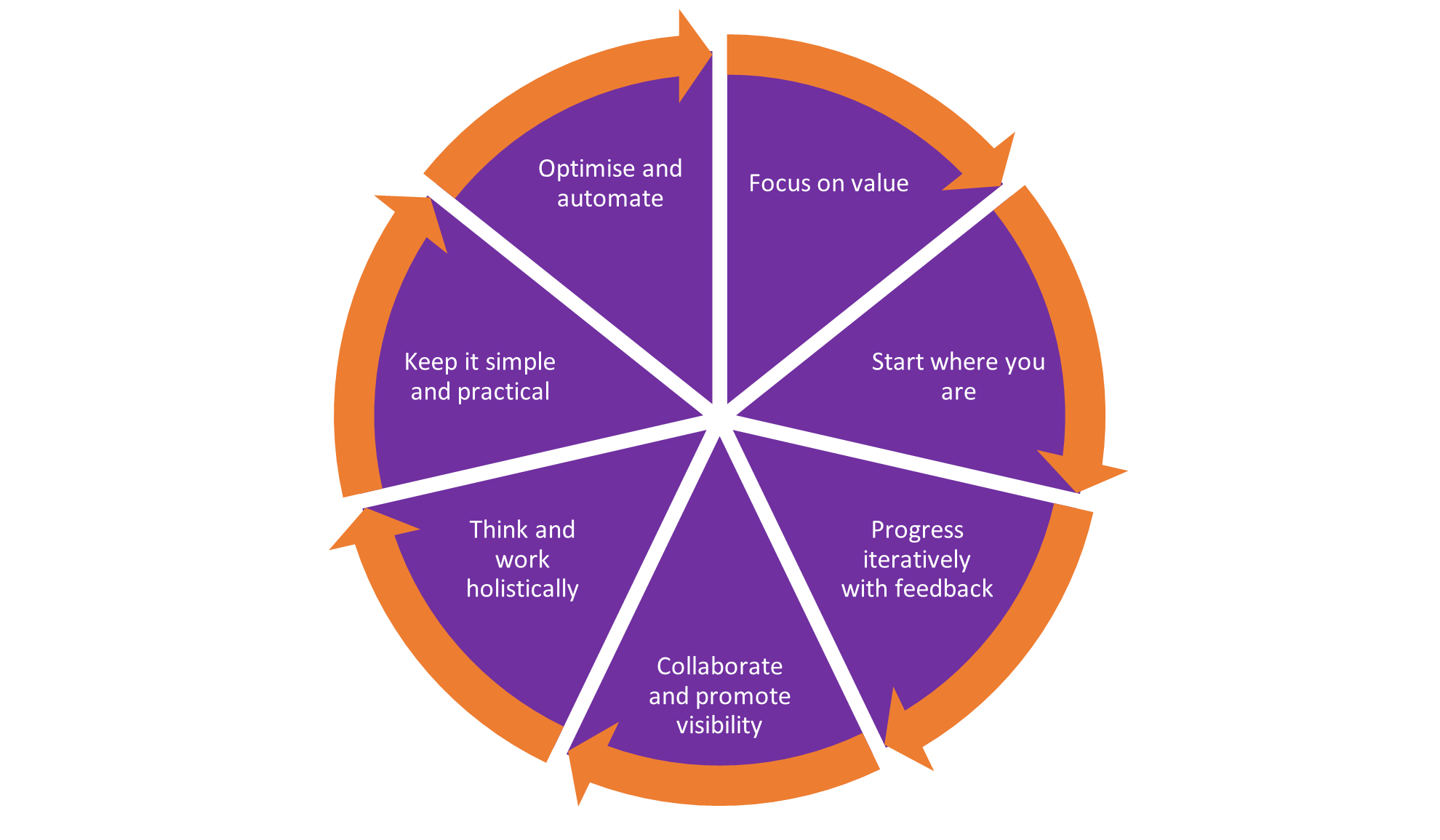
Focus On Value
The principle of Focus on value encourages organisations to focus on delivering value to customers and stakeholders through the IT service management processes. This principle is about ensuring that all activities and decisions within ITSM are aligned with the organisation's overall goals and objectives.
To achieve this principle, organisations should establish clear and measurable objectives, and ensure that these objectives are aligned with the overall goals of the organisation. They should measure and track the value that is being delivered to customers and identify improvements to their services. Additionally, organisations should involve customers in the design and delivery of services, to ensure that they are meeting their needs.
Start Where You Are
The Start where you are principle encourages organisations to begin their IT service management journey from their current state, rather than trying to implement all best practices and standards at once. This principle is about being pragmatic by recognising that organisations have different levels of maturity.
To achieve this principle successfully, organisations should conduct a thorough assessment of their current ITSM processes and capabilities. Then develop a plan for implementing changes and improvements incrementally, starting with the most critical areas first. This principle is also about being flexible, adapting the approach as the organisation's needs, circumstances, and environments change.
Progress Iteratively With Feedback
This principle encourages organisations to adopt an iterative and incremental approach to improving their IT service management processes. Make small, incremental changes, and continuously monitor and evaluate the data. It also emphasises the importance of gathering feedback from customers and stakeholders and using their feedback to make further incremental improvements.
To achieve this principle, organisations should establish a structured and systematic process for making improvements to their ITSM processes, such as using a continuous improvement framework. They should also establish metrics and key performance indicators (KPIs) to measure the performance of their ITSM processes and use this data to identify key areas for improvement. Organisations should also establish a feedback mechanism, such as a customer satisfaction survey, to gather feedback from customers and other stakeholders. This principle also encourages organisations to be agile in their approach, based on the data they receive.
Collaborate and Promote Visibility
The collaborate and promote visibility principle fosters a culture of collaboration and transparency, both within the IT service management team and with other parts of an organisation. Effective communication, coordination and cooperation between different teams and departments, delivers high-quality IT services that meet the needs of customers and stakeholders.
To achieve this principle, establish clear roles, responsibilities, and accountabilities for your ITSM processes, and ensure that all team members understand their roles and how they contribute to the overall success of the service. Establish effective communication channels, such as regular team meetings, to ensure that all team members are informed. Additionally, organisations should involve stakeholders in the delivery of services and the services performance, including any service level agreements (SLAs) and report how well the SLAs are being met, to communicate the value of the services.
Think and Work Holistically
The principle of Think and work holistically in ITIL 4 encourages organisations to take a holistic and integrated approach to ITSM. This principle is about recognising that ITSM is not just about managing individual processes or technologies, but rather about managing the entire service lifecycle and understanding how all the different parts of the service integrate.
To achieve this principle, organisations should take a holistic view of the services they are delivering, and how they affect the overall goals and objectives of the organisation. To implement this principle, organisations should establish a governance structure that promotes a holistic view of ITSM and ensure that all teams and departments are aware of the overall service strategy and direction.
Keep It Simple and Practical
The Keep it simple and practical guiding principle encourages organisations to keep their ITSM processes and procedures as straightforward as possible. This principle is about recognising that complex and overly bureaucratic processes can be damaging to delivering high-quality services. This principle also encourages organisations to be pragmatic and to focus on what is important and what will deliver value, while staying compliant.
To achieve this principle, organisations should strive to simplify their ITSM processes and procedures as much as possible, while still ensuring that they are effective and efficient and fit the specific needs of their organisation. To implement this principle, organisations should establish a process for reviewing and simplifying their ITSM processes and procedures, and for evaluating the effectiveness and efficiency of these processes.
Optimise and Automate
The guiding principle of optimise and automate helps organisations improve efficiency, reduce costs, and improve service quality. Recognising that technology can play a vital role in improving the performance of ITSM processes, and that automation can help to reduce the time and effort required to complete routine tasks. This principle also encourages organisations to adopt a data-driven approach, where data is analysed to understand the performance of the service, and to make decisions on where to focus optimisation efforts.
To achieve this principle, organisations should leverage technology and automation to optimise their ITSM processes. They should also establish a process for evaluating the effectiveness of their automation efforts, and for continuously improving their automation capabilities over time. To implement this principle, organisations should establish a process for identifying areas where automation can improve the performance, such as automating repetitive tasks. They should also establish a process for evaluating the effectiveness of their automation efforts.
What Is ITIL 4? How is it Different to ITIL V3?
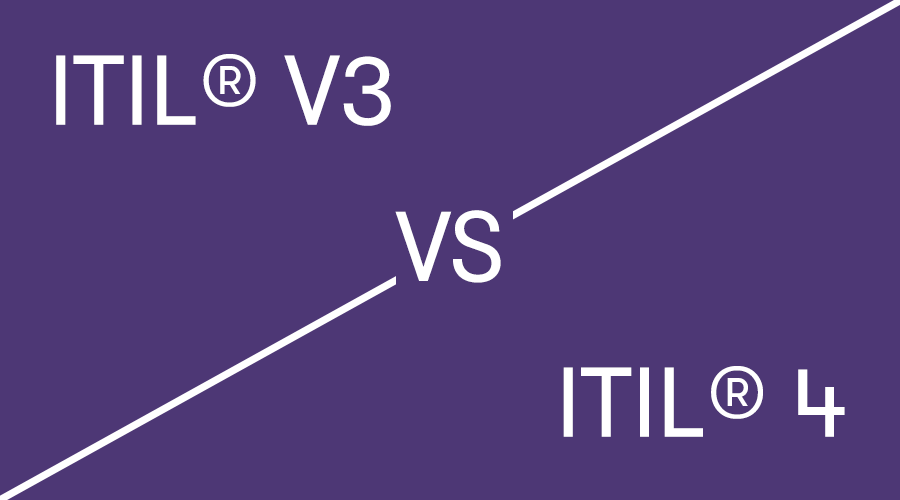
ITIL 4 does not replace ITIL V3 but rather builds upon it.
ITIL V3 focused on the service lifecycle which includes service strategy, service design, service transition, service operation, and continual service improvement. On the other hand, ITIL 4 focuses on the service value system, which includes Engage, obtain/build, design/transition, and deliver/support.
Within ITIL V3 there were 26 processes, ITIL 4 transitioned away from them and designed 34 practices for organisations to integrate and scale.
ITIL 4 acknowledges the importance of Agile, Lean and DevOps methodologies in modern IT service management and provides guidance on how to integrate them with traditional ITIL practices.
Digital Transformation: ITIL 4 also emphasizes the importance of digital transformation in today's business environment and provides guidance on how to align IT services with business goals and objectives.
In summary, ITIL 4 is more holistic, flexible, and adaptable than ITIL V3, providing a more modern and integrated approach to IT service management.
What are the Advantages of Using the ITIL 4 Framework?
Directly answer the question in a couple of sentences and then expand the answer.
Adopting ITIL 4 can not only benefit organisations but also individuals in many ways. There are different levels to adopt ITIL depending on your organisational and individual needs.
Advantages for an organisation
Adopting ITIL can provide several advantages for organisations including improved service quality, better communication, improved customer satisfaction, better risk management, increased efficiency.
Improved Service Quality
ITIL provides a framework for managing IT services that ensures consistency, reliability, and quality. By adopting ITIL practices, organisations can improve service quality, reduce downtime, and increase customer satisfaction.
Increased Efficiency
ITIL processes and best practices help organisations streamline their IT service management operations, which can lead to increased efficiency, reduced costs, and faster delivery of services.
Better Communication
ITIL promotes better communication between IT teams and other departments within an organisation. This can help to ensure that everyone is on the same page, and that IT services are aligned with the needs of the organisation.
Improved Customer Satisfaction
ITIL focuses on providing customer-centric IT services that are aligned with the organisation’s objectives. By adopting ITIL practices, organisations can improve customer satisfaction, which can lead to increased loyalty and revenue.
Competitive Advantage
Organisations that adopt ITIL practices can gain a competitive advantage by providing more reliable and efficient IT services. This can help to differentiate them from their competitors and win new business.
Better Risk Management
ITIL promotes a proactive approach to risk management, which can help organisations to identify and address potential issues before they become major problems.
Scalability
ITIL provides a scalable framework that can be adapted to meet the needs of organisations of all sizes and in all industries.
Overall, adopting ITIL can help organisations to improve their IT service management operations.
Individual advantages
Career Advancement
ITIL 4 certification is highly valued by employers as it demonstrates an individual's knowledge and expertise in IT service management. By obtaining an ITIL 4 certification, an individual can improve their career prospects and increase their earning potential.
Improved Job Performance
By adopting ITIL 4, an individual can develop a better understanding of IT service management best practices, leading to improved job performance. They can use this knowledge to enhance their effectiveness and efficiency in their role.
Enhanced Professional Credibility
ITIL 4 certification is a globally recognised credential that adds to an individual's professional credibility. It demonstrates that the individual has a deep understanding of IT service management best practices and can apply them effectively in their role.
Improved Communication
ITIL 4 provides a common language for IT service management, enabling individuals to communicate effectively with their colleagues, customers, and stakeholders. This can improve collaboration and facilitate the delivery of high-quality IT services.
Continuous Learning
ITIL 4 is a dynamic framework that is continually evolving to meet the changing needs of organisations. By adopting ITIL 4, an individual can stay up to date with the latest IT service management trends and practices, ensuring that their knowledge and skills remain relevant.
What are ITIL Processes and What Are They For?
The purpose of the ITIL 4 processes is to provide a structured approach to managing IT services and ensuring that they are delivered effectively and efficiently. Each of the 34 practices has a set of underpinning processes to help organisations to achieve their objectives. Here is a list of common processes and how they help an organisation:
Service Desk
The purpose of the Service Desk process is to provide a single point of contact for users to report incidents, make service requests, and receive support.
Incident Management
The purpose of the Incident Management process is to restore normal service operations as quickly as possible after an incident has occurred.
Problem Management
The purpose of the Problem Management process is to identify the root cause of incidents and take steps to prevent them from happening again.
Change Management
The purpose of the Change Management process is to ensure that changes to the IT infrastructure are made in a controlled and consistent manner.
Service Level Management
The purpose of the Service Level Management process is to agree and monitor service level targets and ensure that they are achieved.
Service Portfolio Management
The purpose of the Service Portfolio Management process is to manage the entire lifecycle of all services, from conception to retirement.
Availability Management
The purpose of the Availability Management process is to ensure that services are available to users when they need them.
Capacity Management
The purpose of the Capacity Management process is to ensure that IT resources are available when they are needed, and that they are used effectively and efficiently.
What Qualifications Can You Gain for ITIL 4?
ITIL Foundation Certification
The ITIL® 4 Foundation course is the starting point in the ITIL training path. It is the prerequisite for the Managing Professional (MP), Strategic Leader (SL) courses and the Practice courses. The ITIL4 Foundation certification explains how to manage IT services and achieve business value within an organisation. It is a widely accepted approach in IT Service Management (ITSM) and will introduce you to the core principles of ITIL® best practices and key concepts.
ITIL 4 Managing Professional Certification
ITIL 4 Create, Deliver and Support
The ITIL® 4 Specialist Create, Deliver & Support (CDS) course will provide you with an understanding of how to integrate different value streams and activities to create, deliver and support IT-enabled products and services, and relevant practices, methods and tools.
ITIL 4 Drive Stakeholder Value
ITIL® 4 Specialist Drive Stakeholder Value (DSV) training course covers all types of engagement and interaction between a service provider and their customers, users, suppliers and partners. It will provide you with the tools to increase stakeholder satisfaction by co-creating value which is integral to business success in the modern service economy.
ITIL 4 High Velocity IT
ITIL® 4 Specialist High Velocity IT (HVIT) course explores the ways in which digital organisations and digital operating models function in high velocity environments. The course includes the use of working practices such as Agile and Lean, and technical practices and technologies to rapidly deliver products and services to obtain maximum value.
ITIL 4 Direct Plan and Improve
ITIL® 4 Strategist Direct, Plan & Improve (DPI) course covers the influence and impact of Agile and Lean ways of working, and how they can be leveraged to an organisation's advantage. The course provides a practical and strategic method for planning and delivering continual improvement with necessary agility.
ITIL 4 Strategic Leader Certification
ITIL 4 Direct, Plan, and Improve
ITIL® 4 Strategist Direct, Plan & Improve (DPI) course covers the influence and impact of Agile and Lean ways of working and how they can be leveraged to an organisation's advantage. The course provides a practical and strategic method for planning and delivering continual improvement with the necessary agility.
ITIL 4 Digital and IT Strategy
ITIL® 4 Leader Digital & IT Strategy (DITS) course adds a new perspective to the ITIL4 guidance and elevates concepts to an organisational strategy level. The course covers how ITIL can be integrated with emerging practices and new technologies to align with the organisational goals.
ITIL® 4 Specialist Acquiring & Managing Cloud Services (AMCS)
ITIL® 4 Specialist Acquiring & Managing Cloud Services (AMCS) course provides the concept of the cloud services user journey, which aligns ITIL concepts such as guiding principles and the service value chain to provide a holistic view and understanding of the entire procurement lifecycle.
ITIL® 4 Specialist Sustainability in Digital & IT (SDIT)
ITIL® 4 Specialist Sustainability In Digital & IT (SDIT) course explores how service organisations may address sustainability challenges in relation to their digital and IT strategies, tactics, and operations, focusing on the Service Value Chain and ITIL practices.
ITIL® 4 Specialist Business Relationship Management (BRM)
Our ITIL® 4 Specialist Business Relationship Management training course will explore the key concepts, principles, values, and challenges of the BRM practice. It will give you day-to-day perspectives on how to apply in-practice concepts such as stakeholders analysis and management of requirements, Business Relationship Management roles and responsibilities, models and techniques, and service relationships.
ITIL® 4 Specialist IT Asset Management (ITAM)
IT Asset Management training course will explore the key concepts, principles, values and challenges of the ITAM practice. It will give you best practice guidance at both strategic and operational levels on how to maximise value creation, control costs, manage risks, meet regulatory and contractual requirements, and support decision-making about the purchase, re-use, retirement, and disposal of IT assets, including their impact on sustainability.
ITIL® 4 Practices
There are 34 ITIL® management practices in total, representing some of the most practical resources of the framework. The individual practices will be offered through one-day training courses or bundled and combined in a three-day training course bundle. The practices will also be enriched with additional guidance on the capability model based on the ITIL® 4 maturity model.
ITIL® Master
ITL Master is awarded to candidates who achieve Practice Manager (PM), Managing Professional (MP), and Strategic Leader (SL) designations. To achieve the practice manager designation, you must achieve ITIL MP CDS certificate and any five practice-based certifications, either individually or as one of the three pre-bundled courses. These may include ITAM and BRM modules or any practices from the practice manager track.
Where Can You Learn More About ITIL 4?
There are many sources where you can learn about ITIL 4. Here are just a few of them.
Attend a training course
We offer over 200 training courses, including every ITIL course currently available. Click here to view our upcoming courses.
Subscribe to MyAxelos
MyAxelos is a repository of information, tools, templates, and insights to help you make best practices happen for £9.99+VAT a month.
Subscribe to our newsletter
We send out newsletters twice a week which includes upcoming courses, discounts, blogs, videos and much more.
Read more of our blogs
Here are a few we recommend to broaden your ITIL 4 knowledge:
E-Learning
Just like our live tutor-led training courses, we offer the same courses, available as self-paced E-Learning. Click here to check them out.
Trawl the internet
There are massive amounts of content out there on ITIL 4. Finding good content, though, can be difficult.
Get in contact with us
There are multiple ways you can get in contact with us:
- Email: [email protected]
- Phone: +44(0)1539 736 828
- Online chat: Please use the chat box at the bottom of the screen.
- Ask us a question in the comments of this blog
Final Notes on The ITIL 4 Framework
ITIL 4 is important because it provides a comprehensive framework for managing IT services in a way that is customer-focused, agile, and aligned with your organisation’s objectives.
It can help your organisation to improve efficiency, effectiveness, and customer satisfaction and provides a clear path for individuals who want to develop their skills and expertise in IT service management.
Ok, so this is the end of our blog post looking at the question: What is ITIL 4?
To learn more about ITIL 4 and gain certification. Why not check out our ITIL 4 Foundation page?


